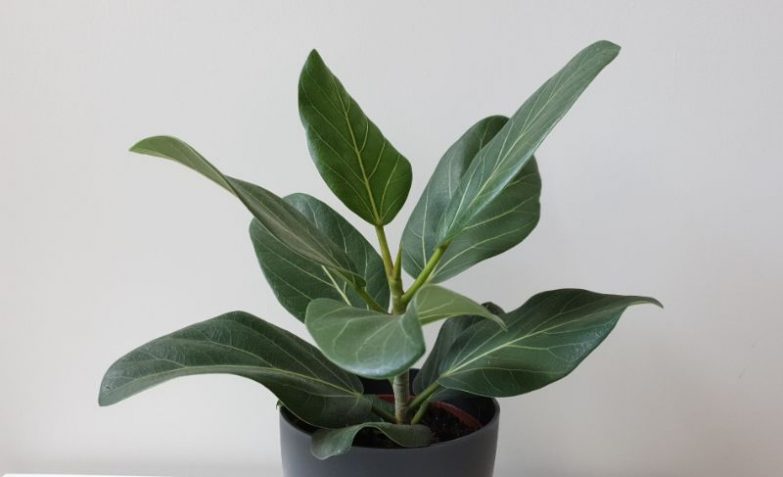Some experts see the trending Ficus Audrey as a contender for the Fiddle-Leaf Fig’s long-held position at the top of the charts. That’s good news to many gardeners because Ficus Audrey is less demanding while offering a similar bold “statement” for interior spaces. In this article, we’ll explain everything you need to know about Ficus Audrey care to keep this popular houseplant thriving.
Ficus Audrey needs warm temperatures, bright to medium indirect light, and consistently moist, well-draining soil in a stable environment – the plant sheds leaves easily if stressed. It likes humidity but will tolerate normal levels indoors. Provide light fertilization through the growing season.
Ficus Audrey Overview
The Ficus benghalensis ‘Audrey’ is a banyan tree native to India and the surrounding region. It’s a type of Strangler Fig.
Banyan trees can grow to epic proportions in the wild, reaching over 70 feet high, with a canopy measured in acres! Yes, acres. They typically “only” reach up to ten feet high when potted. Young specimens are attractive and well-filled even at an early age.
The open tree structure features emerald-green, oval leaves with prominent veins and a velvety texture. The leaves measure about three inches wide on mature specimens. Another highlight is its sturdy, light-colored trunk that thickens with age.
The Ficus Audrey is more forgiving than the Fiddle-Leaf Fig – but that doesn’t necessarily say much. It shares the frustrating family habit of easily shedding leaves. Even if it’s not a beginner’s tree, however, Ficus Audrey can adjust to a range of light and humidity.
Whether planted outdoors or in a container, Ficus Audrey likes warm temperatures and slows down over the winter months. It keeps its leaves year-round (ideally!).
Ficus Audrey Care Summary
| Scientific Name | Ficus benghalensis ‘Audrey’ |
| Origin | India |
| Light Requirements | Bright, indirect light. Avoid more than 1-2 hours of direct sunlight per day. Low light can result in leaf drop and slow growth. |
| Watering | Water thoroughly once the top 1-2 inches of soil dries out. Maintaining consistently moist, but not soggy soil is very important for providing good Ficus Audrey care. |
| Soil | Well draining soil is very important. My preferred mix is 50% peat moss, 30% perlite, 10% coarse sand, and 10% worm castings. |
| Temperature | Does best in temperatures of 70ºF (21ºC) to 80ºF (27ºC). A little warmer will be okay, but it’s best not to go lower than 60ºF (16ºC). |
| Fertilizer | Fertilize monthly while actively growing with a balanced fertilizer. Dilute most fertilizers to half the recommended strength. A little goes a long way. |
| Humidity | Ficus Audrey prefers moderate to high humidity but can cope reasonably well in more arid conditions. Aim for a humidity level of >40% for best results. |
| Flowering | No visible flowers |
| Pruning | Regular pruning is important to shape your plant, maintain size, and to encourage compact growth. |
| Propagation | Stem cuttings can be propagated in water or soil. High humidity will increase the success rate. |
| Re-Potting | Only repot when plant health starts to be impacted by being rootbound. |
| Diseases and Pests | Prone to sap-sucking houseplant pests, but usually recover easily if treated promptly. Fungal leaf-spot diseases such as cercospora can be an issue, as can root rot secondary to overwatering. |
| Toxicity | The sap can be irritant to the skin. Ingestion can cause GI upset. |
| Where To Buy | Buy Ficus Audrey online at Etsy (I buy most of my houseplants from Etsy). |
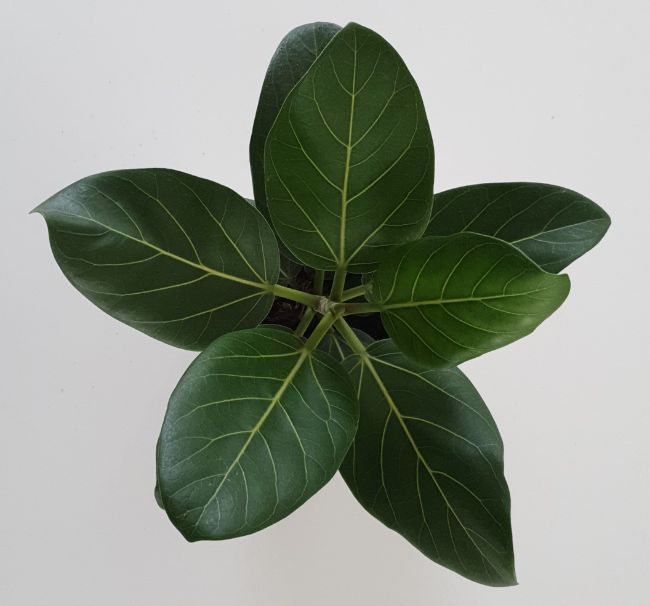
Medium To Bright Indirect Light
One reason Ficus benghalensis ‘Audrey’ is moving into the Fiddle-Leaf Fig’s lane is that it doesn’t demand a space filled with large windows to give them the perfect light exposure. They do well in medium to bright indirect light and will work with a range of conditions. See this article for more info on how to provide bright, indirect light for your houseplants.
There are limits to its composure, however. Low light won’t suit them; they will stop growing and drop leaves if their illumination is too dim. They generally need more than a north-facing window but do well in other orientations.
East-facing – This may be the best exposure, because you can put your Ficus Audrey right up to the panes and let them enjoy gentle direct morning sun.
West-facing – The long daylight hours are great, but be prepared to move their pot a foot or so back if necessary. They can take late afternoon sun if it’s not too hot.
South-facing – This is the brightest exposure and is often a great winter option. Depending upon your latitude, you may need to pull them a few feet from the window if the sun is too direct.
Balanced Watering
Watering is the aspect of Ficus Audrey care that requires the most attention. Ficus Audrey needs to have steady moisture in the soil without ever getting wet feet.
If you give them a drought, just take out the broom for those lovely leaves; if you leave them in sodden soil, on the other hand, you could lose the entire plant to root rot.
The general recommendation is to let the top two inches of soil dry out before rewatering. If you’re in doubt, water less rather than more. Read my article on how to water houseplants for more info.
Some growers water as soon as the surface feels dry, but that may be overkill – especially if you have trouble with soil gnats. These flying pests live in the top layer of soil and need moisture to, well, keep being pests … letting the top two inches of soil dry out keeps them at bay.
Ficus Audrey’s leaves are expressive and will let you know if things aren’t kosher. Here are signs to look for:
Overwatering – Downward leaf curl, yellowing, or dark spots on the leaves are typical signs of overwatering. Check your routine. If you don’t think you’re actually overwatering the plant, check the soil: it could be holding too much moisture.
Note: Another indication the soil has insufficient drainage is taking more than a week to dry out enough for rewatering.
Underwatering – Upward curling leaves, yellowing foliage, or crispy spots can all be signs of too little water. (A pest infestation can cause similar symptoms.)
Give the soil a thorough drenching each time you water and let the excess flow out the drain holes. This helps ensure the soil is completely moistened and flushes the medium of fertilizer salts and other residues. Giving the plant small sips can lead to a buildup of these toxins.
How To Water Ficus Audrey In A Large Container
Watering a large Ficus Audrey can present a challenge. Lifting the pot is a great way to judge whether a plant needs water, but a large container makes this difficult. Also, it’s easy to be misled by the topsoil: lower regions of a deep pot can remain saturated even when the surface is dry.
One effective way to monitor a large pot is to use a wooden probe that can reach to the bottom. Insert it all the way into the soil and wait a moment before drawing it back out. Gauge the soil’s bottom moisture by how wet the tip is.
Note: Electronic water meters can be undependable because they give different results in different soils.
If the lower soil is consistently wet when the top layer has dried, the soil is probably too heavy. You may not need to repot immediately if the plant is doing well, but monitor it carefully.
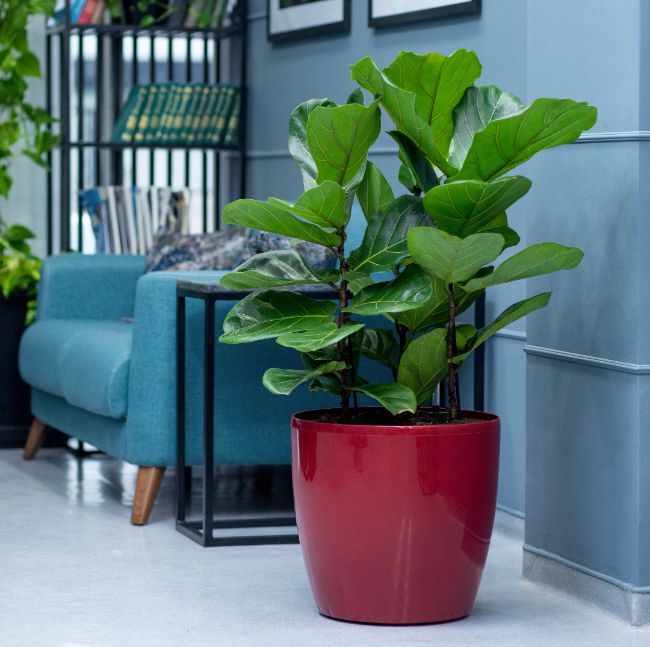
Soil For Ficus Audrey
As long as it drains well enough, the Ficus Audrey isn’t too picky about its soil. The ideal mix stays open and oxygenated even after a thorough watering, yet holds enough moisture to last several days before drying out.
My preferred mix for Ficus Audrey consists of the following;
- 50% peat moss or coco coir
- 30% perlite
- 10% coarse sand
- 10% organic compost or worm castings.
This type of soil lets you inundate the pot to flush it out while retaining aeration. Maintaining the right soil moisture is much harder if the soil is heavy.
Retail soils can be a good base to start from, but many will hold too much water for Ficus Audrey. To get the right consistency, add one of several excellent aerating amendments:
- Perlite
- Coco Coir
- Pumice
- Coarse Sand
Bark, woodchips, peat moss, and other organics loosen up the soil in the short term, but they decompose rapidly in moist conditions and become compact. Some growers use them anyway and replenish the soil annually, but that’s a bit more disturbance than an older plant likes.
Read my guide to choosing and making potting mix for your houseplants for more info.
Normal Humidity
While your Ficus benghalensis ‘Audrey’ likes humidity as much as the next beautiful tropical evergreen, it’s not a pouting diva-like some plants we could name. As long as you don’t live in an extremely dry climate and their soil is kept properly moist, the Audrey can do fine in normal humidity.
That said, you might see seasonal issues. Indoor heating in cold weather can turn your home into an indoor desert. If you’re seeing brown-edged or lackluster leaves, consider upping the humidity.
A room humidifier certainly works, but it’s probably not necessary. You can modestly raise local humidity by placing water-filled trays near the plant, or by grouping it with other lush tropicals. I’ve written more about the best ways to raise humidity for your plants here.
Ficus Audrey Temperature Requirements
The Ficus Audrey is a warm weather plant that does fine in normal room temperatures year-round. Its favored range is about 70ºF (21ºC) to 80ºF (27ºC). A little warmer will be okay, but it’s best not to go lower than 60ºF (16ºC).
Obviously the plant isn’t frost-tolerant – but it won’t appreciate a dip below 55ºF (13ºC), either. It doesn’t like cold drafts and certainly isn’t shy about dropping leaves to tell you so.
If your Ficus Audrey is outgrowing your space and you’d rather not deal with root pruning, you can plant them outdoors in USDA Zones 10 to 12.
How To Fertilize Ficus Audrey
Your Ficus Audrey grows actively in warm weather and will appreciate moderate fertilization. They favor a balanced formula with a bit extra nitrogen.
Symptoms of under-nutrition are little growth or leaves with yellow margins in a healthy plant that has warm conditions and good light. Too little soil fertility isn’t very common, but it can occur.
A liquid solution is easy to measure and helps ensure the entire root system is fed.
There are two main regimens:
Monthly – Dilute the fertilizer to half the recommended dosage. You can feed more often if you adjust the dilution accordingly.
With Each Watering – Applying the fertilizer in a highly diluted form every time you water guarantees you won’t lose track of your feeding schedule. Use a quarter of a teaspoon or less per gallon.
Organic fertilizers can naturally offer a higher nitrogen profile and are less likely to burn the roots from an overdose. Organics also help promote a healthy microbial soil population.
Stop fertilizing during the cooler months. Be alert to periods of little growth – don’t keep dumping fertilizer into an inactive plant.
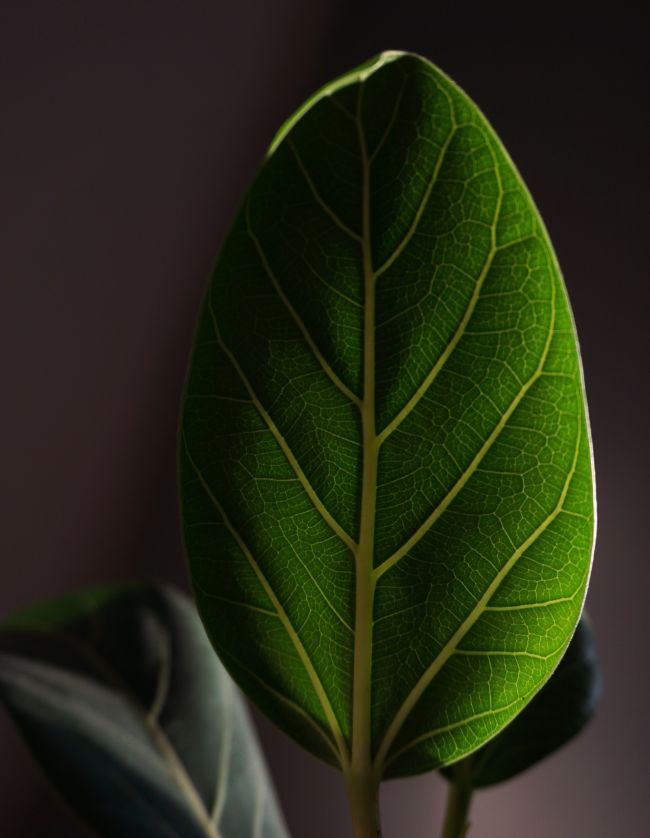
No Visible Flowers
Your Ficus Audrey doesn’t have traditional flowers … or none you can see.
The reproductive blossoms are inside the fruit; they are pollinated by insects who enter through specialized “doors” into the chamber. Without these pollinators, the seeds remain sterile.
Pruning Matters
Even if you don’t have a goal in mind, pruning is an important aspect of Ficus Audrey care, to ensure your plant looks its best. They can be trimmed any time of the year but recover more quickly in the spring or early summer.
- Use sharp shears sterilized with isopropyl (rubbing) alcohol or other effective means.
- The latex-like sap can irritate skin and stain the surroundings, so take precautions. Wear gloves and cover exposed areas. You can quickly stop the sap’s flow by misting or putting paper over the cut.
- Trim dead or dying branches as needed. Cut off aerial roots as you prefer; it won’t hurt the plant.
Shaping Your Tree
Ficus Audrey can be grown in a columnar form or a traditional tree shape. Here are common techniques:
- Cut the top off a tree once it reaches your preferred height. For appearance’s sake, the plant will probably benefit from some preparatory trimming … so get started!
- To encourage branching, cut the chosen branch back. Keep one to three leaves: new buds will form at the base of the remaining foliage.
- To keep the structure open, prune so that emerging branches grow outwards.
- Trim crisscrossing branches and those that grow downwards or into the center.
- Correct crooked branches by cutting them back to a section growing toward an imaginary center line.
- To create a harmonious picture, trim branches so they grow closer together as they reach the top, as happens in nature.
Read my guide to pruning houseplants to make sure your plants always look their best.
Repotting
A Ficus Audrey doesn’t need frequent repotting; they need it even less as they grow older. Their root system grows modestly when potted and the plant does well when slightly rootbound.
Young plants may benefit from annual repotting, but every three years is generally enough for a mature specimen.
Tips:
- Only increase the container by one size, or up to two inches in diameter.
- Repot early in the season so the plant can rapidly recover.
- Try not to disturb the roots. Simply put fresh soil beneath and around the rootball in the new, larger pot.
- Don’t put extra soil over roots that emerge from the surface. Trim them if you don’t like the look.
- To keep the plant in the same pot, prune the roots. Also, cut back foliage since there are fewer roots for support.
- Learn more about how to repot your houseplants in this article.
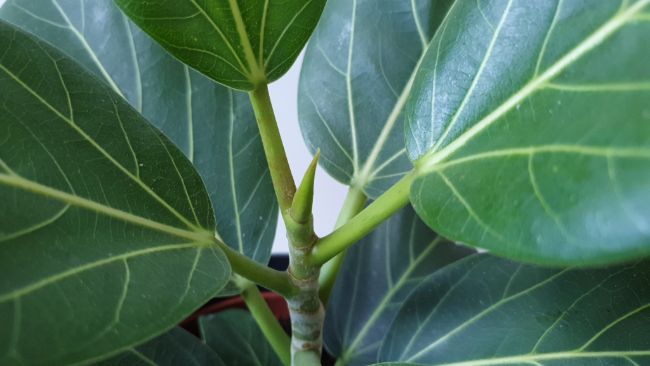
How To Propagate Ficus Audrey
Asexual reproduction via stem cuttings can be challenging, but it’s the practical propagation method for a Ficus Audrey.
Sterilize your tools, and make sure the new soil is sterile, too. Cuttings are vulnerable and easily succumb to pathogens.
1) Take three to six inch-long cuttings from the tips of healthy stems. Misting or holding a paper towel to the cuts helps staunch the sap flow.
2) Air dry the cuttings for a few hours to let the sap harden. This helps prevent rot.
Pro Tip: Dust the cut end with cinnamon powder to thwart fungus.
3) You can place the stem either directly in soil or in water to watch the roots sprout. Give the cutting the same light the mother plant receives.
Rooting in Water: Put the stem into room temperature, filtered water with its leaves above the water line. Transplant into soil once the roots are one to three inches in length.
Direct to Soil: Apply rooting hormone to the cut ends and insert into the planting medium. Keep the temperature from 70°F (21°C) – 75°F (24°C).
Note: A heating pad can ensure the ideal temperature for rooting.
Once the new plant is in soil – using either method – you can give them a leg up by tenting them in clear plastic. This raises humidity and keeps their soil moist.
Ficus Audrey Care Tips
- While Ficus Audrey will adapt to average humidity, remember that winter heating can dry the air enough to cause stress.
- Rotate the container so that your plant grows evenly. Turning the pot clockwise one quarter each time you water is a good method.
- Dust the leaves or wipe them gently with a damp cloth. This helps them breathe and gives you a routine opportunity to inspect the leaves for pests.
- If you want to encourage the plant’s aerial roots, try wrapping the base (or wherever you’d like roots) with a plastic “collar” made from a trimmed water bottle. Increasing that area’s humidity may stimulate root production.
Leaf Drop
It’s normal for a Ficus Audrey to shed leaves occasionally, but they are known for responding to stress by disrobing en masse. Here are possible causes:
Environmental Change – Shedding leaves is the plant’s go-to response to relocation or other change. Expect a leaf shower after bringing a new plant home – but even the natural change of seasons can bring on loss. The best policy is to place your Ficus Audrey in a good spot and leave her there!
Improper Watering – A Ficus Audrey loses leaves whether under or overwatered. If the pot has gone completely dry, give it a thorough soaking to make sure it’s well rehydrated. Don’t just add water if you see an issue, however: root rot is even more deadly.
Inadequate Light – A deficiency in light triggers shedding … a plant struggling with dim conditions will become sparse over time. Move her to a brighter spot or boost the light with artificial sources.
Pests and Disease – Pests can cause leaf loss, but try not to let that be your first clue of an infestation. Fungal problems can also cause leaf spots and eventual shedding.
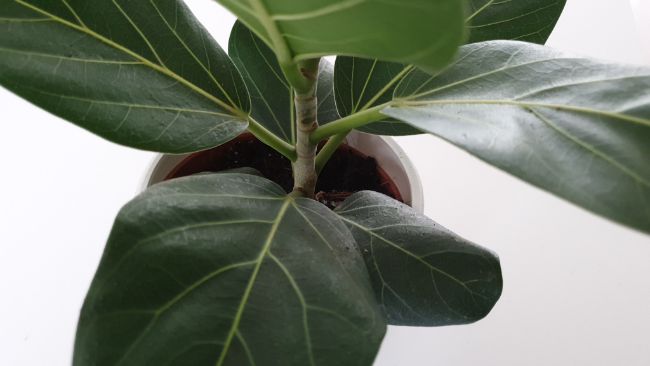
Toxicity
The main danger to humans from a Ficus Audrey is that their sap can irritate skin, although it can also cause intestinal distress if ingested.
Pets are more at risk, and any part of the plant can cause nausea and other complications if eaten. Severe problems are uncommon, but it’s a good idea to keep leaves swept up if you have pets around.
Varieties
The Ficus genus has over 800 species, including the popular Weeping Fig (Ficus benjamina), Rubber Tree Plant (Ficus elastica), and of course the Fiddle-Leaf Fig (Ficus lyrata).
There’s only one Audrey Fig variety. It may seem that your tame Ficus Audrey bears little resemblance to the enormous banyan trees of India, but the main difference is scale.
Pests And Diseases
Ficus Audrey care is sometimes made more challenging by the presence of common houseplant pests. Check regularly, especially under the leaves. It’s best to catch an infestation before it sets in.
You can remove individual pests with rubbing alcohol, but you’ll need to do more if the invaders become established. Here are some effective solutions:
Insecticidal Soap – This treatment is gentle on the plant and safe to use indoors. It’s only effective if it touches the pests while wet, so thoroughly cover the plant.
Light Horticultural Oil – Another safe and gentle treatment, this oil works by smothering the pests. It must be thoroughly applied.
Neem – There are two forms of this pesticide: the natural oil containing azadirachtin, an organic insecticide, and a refined product that strips out this active ingredient and acts essentially like horticultural oil.
Chemical Pesticides – Pyrethrums and other rigorous treatments are more toxic. Research the product and take precautions. If you’re using harsh chemicals indoors, remember that they linger and are poisonous to more than insects.
Fungal Disease
Ficus Audrey can fall prey to various moisture-related pathogens if their soil stays too moist or the humidity is high. The best prevention is to avoid getting the leaves wet and to let the soil dry appropriately before rewatering.
One common affliction is a Leaf Spot Fungus called cercospora. It causes small black dots on foliage; in advanced cases, the leaves can turn yellow and drop off. Remove the affected leaves and spray with a sulphur or copper-based fungicide.
Last Word
I hope I’ve covered all your questions about Ficus Audrey care and that your plant thrives for years to come. If you’ve been struggling to keep your houseplants healthy and looking great, check out my book, Houseplants Made Easy. I cover everything you need to know to keep your houseplants thriving and looking amazing all year round.

